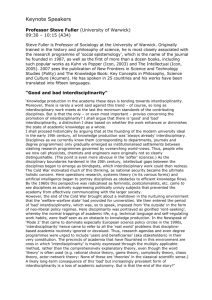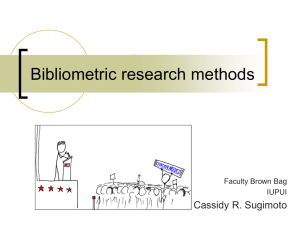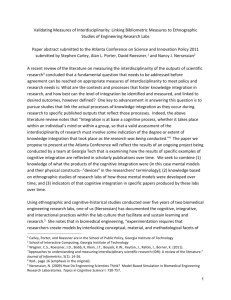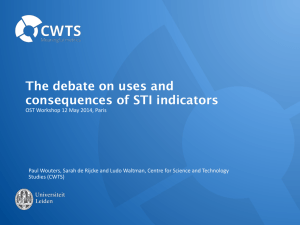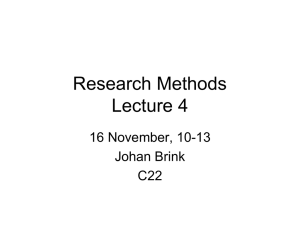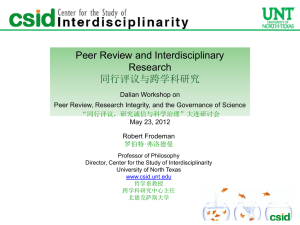Influence of interdisciplinarity on peer-review and bibliometric evaluations in physics research
advertisement
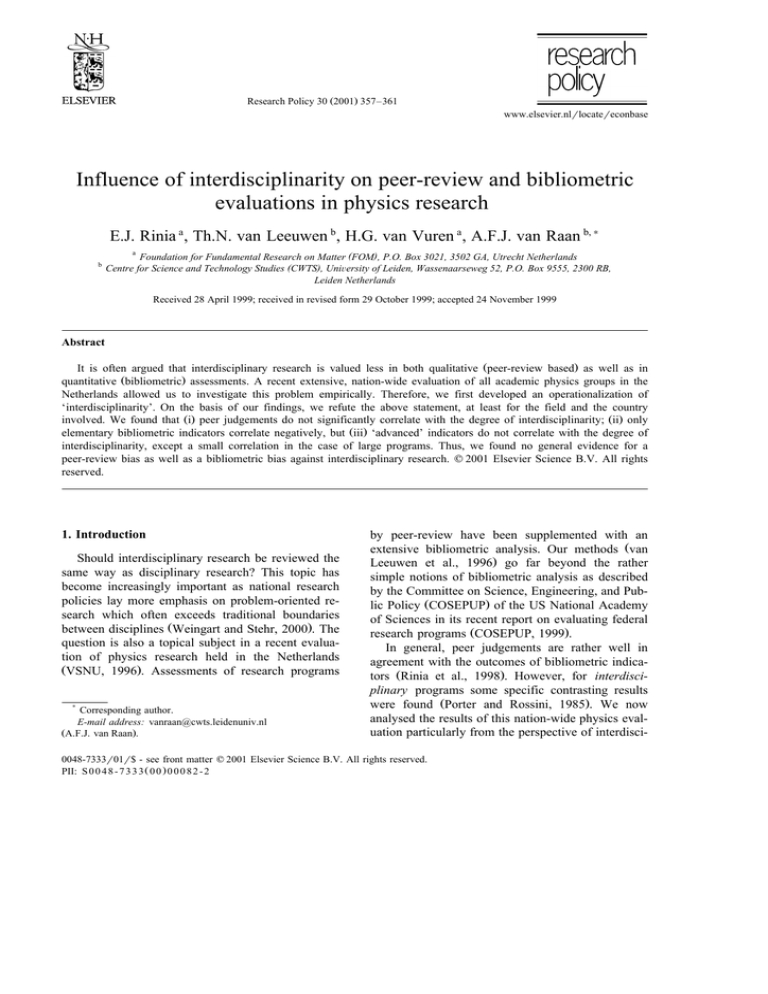
Research Policy 30 Ž2001. 357–361 www.elsevier.nlrlocatereconbase Influence of interdisciplinarity on peer-review and bibliometric evaluations in physics research E.J. Rinia a , Th.N. van Leeuwen b, H.G. van Vuren a , A.F.J. van Raan b,) b a Foundation for Fundamental Research on Matter (FOM), P.O. Box 3021, 3502 GA, Utrecht Netherlands Centre for Science and Technology Studies (CWTS), UniÕersity of Leiden, Wassenaarseweg 52, P.O. Box 9555, 2300 RB, Leiden Netherlands Received 28 April 1999; received in revised form 29 October 1999; accepted 24 November 1999 Abstract It is often argued that interdisciplinary research is valued less in both qualitative Žpeer-review based. as well as in quantitative Žbibliometric. assessments. A recent extensive, nation-wide evaluation of all academic physics groups in the Netherlands allowed us to investigate this problem empirically. Therefore, we first developed an operationalization of ‘interdisciplinarity’. On the basis of our findings, we refute the above statement, at least for the field and the country involved. We found that Ži. peer judgements do not significantly correlate with the degree of interdisciplinarity; Žii. only elementary bibliometric indicators correlate negatively, but Žiii. ‘advanced’ indicators do not correlate with the degree of interdisciplinarity, except a small correlation in the case of large programs. Thus, we found no general evidence for a peer-review bias as well as a bibliometric bias against interdisciplinary research. q 2001 Elsevier Science B.V. All rights reserved. 1. Introduction Should interdisciplinary research be reviewed the same way as disciplinary research? This topic has become increasingly important as national research policies lay more emphasis on problem-oriented research which often exceeds traditional boundaries between disciplines ŽWeingart and Stehr, 2000.. The question is also a topical subject in a recent evaluation of physics research held in the Netherlands ŽVSNU, 1996.. Assessments of research programs ) Corresponding author. E-mail address: vanraan@cwts.leidenuniv.nl ŽA.F.J. van Raan.. by peer-review have been supplemented with an extensive bibliometric analysis. Our methods Žvan Leeuwen et al., 1996. go far beyond the rather simple notions of bibliometric analysis as described by the Committee on Science, Engineering, and Public Policy ŽCOSEPUP. of the US National Academy of Sciences in its recent report on evaluating federal research programs ŽCOSEPUP, 1999.. In general, peer judgements are rather well in agreement with the outcomes of bibliometric indicators ŽRinia et al., 1998.. However, for interdisciplinary programs some specific contrasting results were found ŽPorter and Rossini, 1985.. We now analysed the results of this nation-wide physics evaluation particularly from the perspective of interdisci- 0048-7333r01r$ - see front matter q 2001 Elsevier Science B.V. All rights reserved. PII: S 0 0 4 8 - 7 3 3 3 Ž 0 0 . 0 0 0 8 2 - 2 358 E.J. Rinia et al.r Research Policy 30 (2001) 357–361 plinarity. The concept of interdisciplinarity is operationalized as the extent to which articles are published in journals in other scientific fields than the main field Žphysics. of a program. 2. Methodological Approach The quality assessment procedure of the universities in the Netherlands consists of a discipline-wise judgement of research performance by international committees of independent experts. In this context an evaluation of Dutch academic physics was carried out by the International Review Committee for Physics ŽVSNU, 1996.. In an additional bibliometric analysis, which was made available in a final round to the Committee, we gathered data for about 200 academic physics research programs, covering more than 15,000 publications in the period 1985–1994. For a detailed presentation of the applied bibliometric approach and in particular the construction of the advanced indicators, we refer to van Leeuwen et al., 1996, also available via our website1, and to van Raan, 1996. We now used these bibliometric data to construct, for each program, a ‘research profile’ which represents the frequency distribution of publications over research Žsub.fields Ždefined by journal classification according to the ‘journal categories’ of the Institute of Scientific Information, ISI.. On the basis of ample empirical experiences with the thus defined research profiles see Žvan Raan, 1996, and our contribution to Weingart and Stehr, 2000. we claim that this approach provides a sufficiently reliable representation of interdisciplinarity. In Table 1 we present as an example one of the research programs with 476 publications, 271 of which can be assigned to physics Ži.e., the journals concerned belong to physics fields., and 205 are published in journals which belong to non-physics fields. So the percentage of ‘nonphysics’ papers is 43%. We define the percentage of non-physics papers as the degree of interdisciplinar- 1 Our webside is http:rrsahara.fsw.leidenuniv.nlrcwtsr cwtshome.html. Table 1 Distribution of publications of an arbitrary programme over research Žsub.fields. Publications may be attributed to more than one Žsub.field. In that case they are fractionally counted Subfield Main Field Number of Publications PHYSICS, PART & FI PHYSICS, NUCLEAR PHYSICS, MISCELL PHYSICS, MATHEMA PHYSICS, COND MA PHYSICS, AT,M,C PHYSICS, APPLIED PHYSICS ŽGEN.. Subtotal physics subfields MULTIDISCIPL SC METALLURG & MINING MATERIALS SC MATER SC, COATING ENGINEERING ENG, ELECTRICAL ELECTROCHEMISTRY CRYSTALLOGRAPHY COMPU SCI, INT AP CHEM,PHYSICAL CHEM, INORG & NUC ASTRON & ASTROPH Subtotal non-physics subfields Total PHYS PHYS PHYS PHYS PHYS PHYS PHYS PHYS 17.0 3.3 1.0 1.0 146.2 4.3 50.5 47.3 270.7 5.5 55.8 66.8 0.8 5.5 6.5 0.5 1.0 1.0 61.0 0.5 0.3 205.3 476.0 MULT META MATE MATE ENGI ENGI ELEC CRYS COMP CHEM CHEM ASTR ity. The analysis was restricted to 185 programs with 10 or more publications, with an average number of 96 publications. As can be observed in Table 1, interdisciplinarity in this study does not cover a very broad spectrum of fields. It is confined to fields rather closely related to physics, such as engineering and chemistry. 3. Empirical findings The distribution of interdisciplinarity of physics research programs in the Netherlands is given in Fig. 1. The average degree of interdisciplinarity per program is 36%. For 93 programs a quality judgement was given by the International Review Committee for Physics, which was compared to the interdisciplinarity of these programs. Calculating a Spearman rank-correlation coefficient between these two variables we find r S s y0.13. We conclude that the E.J. Rinia et al.r Research Policy 30 (2001) 357–361 Fig. 1. Degree of interdisciplinarity of research programmes in physics in the Netherlands Ž1985–1994.. peers did not judge interdisciplinary programs differently than ‘monodisciplinary’ programs. It may also be concluded that, according to the peers, the quality of the more interdisciplinary programs is, on average, equal to that of other more ‘monodisciplinary’ ones. Next we compared results of the whole set of bibliometric indicators Žvan Leeuwen et al., 1996; van Raan, 1996. applied to all 185 physics research programs with the degree of interdisciplinarity of these programs. Linear correlation coefficients Ž r . of logarithmic values of the indicators ŽStewart, 1993. and interdisciplinarity are given in Table 2, where we also distinguish between classes of program size 359 Žin terms of number of publications.. It appears that in several cases the correlation coefficient is significantly negatiÕe. This means that with increasing interdisciplinarity a lower score of the bibliometric indicators concerned is obtained. There are, however, striking differences between the various indicators. First the more elementary indicators. The number of publications Ž P . per program does not significantly correlate with interdisciplinarity. The total number of citations Ž C . of a program, and the average number of citations per paper ŽCPP. show, in the case of the larger programs, a small but significant negatiÕe correlation. Correlation coefficients also show that work in interdisciplinary programs is published in fields characterised by a lower field-specific average number of citations ŽFCSm., and in journals with a lower journal-specific citation mean ŽJCSm.. The latter indicator shows the largest Žnegative. correlation. These correlations may partly be related to the well-known phenomenon that citation characteristics vary by journal and field. In applied fields for instance, they are often lower than in basic science fields. More adÕanced bibliometric indicators correct for these differences by taking world-average citation rates of journals or fields as a reference level Žvan Leeuwen et al., 1996.. Two of such indicators, used in the bibliometric analysis of Dutch academic physics, compare citation averages of a research program with citation averages of its journals ŽCPPrJCSm., and with citation averages of its field Ži.e., all journals in a specific field, CPPrFCSm.. We find that the outcomes of these indicators are considerably less correlated with interdisciplinarity. There is no significant correlation between interdis- Table 2 Linear correlation coefficients Ž r . between interdisciplinarity and bibliometric indicators Žlogarithmic values.. The number of publications per program Žthree size classes. is indicated by n. The number of programs in each class is indicated by N. Correlations significant at a confidence level of 99% are indicated with a ‘q’ sign. The various bibliometric indicators and their symbols are briefly explained in the text and extensively discussed in van Leeuwen et al., Ž1996. and van Raan Ž1996. Number Ž n. of publications per program Number Ž N . of programs I Ž% interdisciplinarity. vs. P C CPP JCSm FCSm CPPrJCSm CPPrFCSm JCSmrFCSm 10–50 50–100 G 100 60 62 63 y0.17 y0.15 y0.17 y0.43 q y0.56 q y0.51 q y0.40 q y0.45 q y0.27 y0.01 0.00 y0.28 y0.10 y0.17 y0.47 q y0.23 q y0.36 q y0.49 q y0.17 y0.39 q y0.53 q y0.28 y0.37 q y0.52 q 360 E.J. Rinia et al.r Research Policy 30 (2001) 357–361 ciplinarity and the indicator normalizing the measured impact of publications of a program to the world-wide citation averages of the journals involved Žsee Table 2, column CPPrJCSm.. This result clearly indicates that interdisciplinary research, at least in Dutch physics, has the same impact as ‘monodisciplinary’ research when citation scores are compared with citation averages of the journals concerned. We conclude that impact normalisation on journal characteristics Žand article type as well. indeed takes into account the scope of the research, in this case the more interdisciplinary character. Measured by the other advanced indicator which normalizes on field citation characteristics Ži.e., all journals in a specific field, CPPrFCSm., interdisciplinarity only shows a small significant, negative correlation in the case of the larger programs. Our explanation is that in such cases field averages are dominated by the larger monodisciplinary journals, and we conclude that ‘fields’ Ždefined as larger sets of journals. are probably too ‘broad’ to have an interdisciplinary focus. Finally, interdisciplinarity and the indicator comparing the journal citation average to the field citation average ŽJCSmrFCSm, in fact a measure of the ‘status’ of the journals used by the researchers in a program., correlate slightly but significantly negative. This again indicates that interdisciplinary research is often published in journals with a citation level below the average of the fields involved. As already noticed in the discussion on the elementary indicators, the results presented in Table 2 show that negative correlations between interdisciplinarity and outcomes of a number of indicators, generally tend to increase for larger programs Žin terms of publication output.. 4. Conclusions Our results demonstrate that peer judgements of Dutch academic physics by a panel of international experts show no significant correlation with the degree of interdisciplinarity of the programs concerned. In other words, it shows that there is no general bias concerning interdisciplinary projects in this quality assessement. Porter and Rossini, Ž1985. found some evidence that interdisciplinary proposals are downgraded in peer review because reviewers tend to rate proposals from their own discipline more favourably. However, these findings are based on a more ‘focused’ peer-review procedure which differs from the above-mentioned evaluation with an expert panel assessing a broad, nation-wide discipline. We showed that interdisciplinary research in the framework of physics programs receives slightly but significantly lower scores on some elementary bibliometric indicators. To our opinion these negative correlations do not reflect differences in scientific impact as assessed by bibliometric indicators between ‘monodisciplinary’ and interdisciplinary research. They are mainly related to differences in citation characteristics between fields and between journals within these fields. This conclusion is supported by the finding that the peers do not judge interdisciplinary programs differently, in combination with the finding that the more advanced indicators which correct for differences between fields and journals, do not correlate significantly with the degree of interdisciplinarity. Thus, both types of assessment do not show a significant bias with respect to interdisciplinarity. Evidently, impact normalisation on journal characteristics takes into account the scope of research, in this case the more interdisciplinary character. We conclude that for interdisciplinary research, the indicator CPPrJCSm Žimpact normalization on journal characteristics. appears to be the most appropriate bibliometric measure. The indicator CPPrFCSm Žimpact normalization on field characteristics. is slightly biased in case of Žlarger. interdisciplinary programs in Dutch physics. The correlations found between degree of interdisciplinarity and the outcomes of elementary citation-based indicators without journal- or field-specific normalization, may be a warning against poorly informed use of citation data, especially in the case of interdisciplinary research. Also the correlations found between interdisciplinarity and the average citation level of journals in which a group publishes, may be a warning particularly against the uninformed use in research performance evaluations of simple citation-based characteristics of journals, like ISI’s journal impact factors ŽMoed and van Leeuwen, 1996.. E.J. Rinia et al.r Research Policy 30 (2001) 357–361 Acknowledgements We thank Dr. H.F. Moed ŽCWTS. for his contributions to the bibliometric study of academic physics in the Netherlands and Dr. E.E.W. Bruins for comments on the statistical analysis. We gratefully acknowledge the Netherlands Organisation for Scientific Research ŽNWO. for financing the major part of the bibliometric data system used in this study. References COSEPUP 1999, Committee on Science, Engineering, and Public Policy. Evaluating Federal research Programs, Research and the Government Performance and Results Act. National Academy Press, Washington DC ŽISBN 0-309-06430-9.. Moed, H.F., van Leeuwen, Th.N., 1996. Impact factors can mislead. Nature 381, 186. Porter, A.L., Rossini, F., 1985. Peer-review of interdisciplinary 361 research proposals. Science, Technology, and Human Values 10, 33–38. Rinia, E.J., Van Leeuwen, Th.N., van Vuren, H.G., Van Raan, A.F.J., 1998. Comparative analysis of a set of bibliometric indicators and central peer review criteria. Evaluation of condensed matter physics in the Netherlands. Research Policy 27 Ž1., 95–107. Stewart, J.A., 1993. The Poisson-lognormal model for bibliometricrscientometric distributions. Information Processing and Management 30, 239–251. van Leeuwen, Th.N., Rinia, E.J., van Raan, A.F.J., 1996 Bibliometric Profiles of Academic Physics Research in the Netherlands. Report CWTS 96-09. Centre for Science and Technology Studies, Leiden Žavailable via our website http:rr sahara.fsw.leidenuniv.nlrcwtsrcwtshome.html. van Raan, A.F.J., 1996. Advanced bibliometric methods as quantitative core of peer review based evaluation and foresight exercises. Scientometrics 36, 397–420. VSNU, 1996. Assessment of Research: An Analysis of Physics in the Dutch Universities in the Nineties. VSNU, Utrecht ŽISBN 90-5588- 041-8.. Weingart, P., Stehr, N. ŽEds.., 2000. Practicing Interdisciplinarity. University of Toronto Press, Toronto.
